The Vinitaly in Verona is over again. It can rightfully call itself one of the three big wine fairs in Europe, besides the Pro-Wein in Düsseldorf and the Vinexpo in Bordeaux. 4.000 exhibitors on 60,000 sqm of exhibition space have again attracted about 150,000 visitors (exact figures were not yet available).
With only three weeks between the fair and ProWein, a comparison is naturally obvious. ProWein is considerably smaller with just under 3,000 exhibitors on about half the exhibition space, which is reflected above all in the number of visitors of only about 25,000. The structure of the visitors is probably the biggest difference between the two fairs. Both are trade fairs. Except for Sunday, which is officially open to private customers at Vinitaly, private visitors are supposed to be left out of both events. Theoretically, anyway! In Düsseldorf, the organisers manage to put this into practice reasonably well. In Verona clearly not.
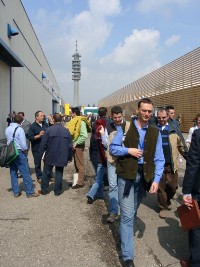 Despite a hefty entrance fee of 30 euros per day (for foreign visitors 20 euros per day or 50 euros for all days), the fair is almost characterized by the exhibitors' efforts to keep "free buyers" and bus tourists away from their stands. Many presentation areas consist of closed walls with a small, controllable entrance. Some well-known exhibitors have already capitulated to the situation. Angelo Gaja, for example, was no longer represented this year for the first time.
Despite a hefty entrance fee of 30 euros per day (for foreign visitors 20 euros per day or 50 euros for all days), the fair is almost characterized by the exhibitors' efforts to keep "free buyers" and bus tourists away from their stands. Many presentation areas consist of closed walls with a small, controllable entrance. Some well-known exhibitors have already capitulated to the situation. Angelo Gaja, for example, was no longer represented this year for the first time.
For most producers, selection is the order of the day. Without a business card, appropriate clothing and a credible appearance, relatively little happens here. You either don't get in at all or there is "unfortunately no more wine in stock". At many stands, appointments are desired or even necessary. Once you have overcome these hurdles, however, you can experience perfect organisation, virtually shielded from the public eye. Here you can get to know the respective wines, accompanied by competent contact persons.
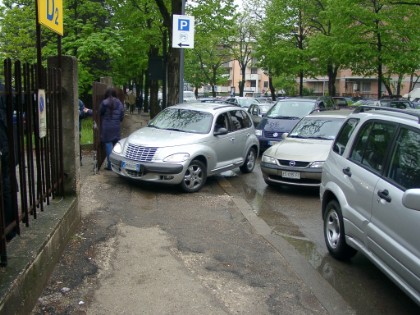
In the picture: By a gigantic horn concert the park guards are "persuaded" to open the gate once again. The fact that this causes traffic to back up for kilometres in both directions is obviously irrelevant
As organised as it is in the stands, as chaotic are the conditions in front of the exhibition grounds. The words traffic chaos and shortage of parking spaces only very inadequately describe the situation. The few parking spaces are out of all proportion to the number of people looking for a parking space. The official parking spaces are full by the start of the fair at the latest. As soon as their barriers and gates no longer open, you have to look for a spot somewhere where you can park your car. As a "proper German", you have to get over the idea of parking your car on street islands, at crossroads or in other unused spaces; but by the fourth day of the fair at the latest, you don't care. By the way, the parking situation educates you to get up early, because the walking distance increases drastically with every minute of delay.
Speaking of getting up early: If you don't book a hotel room many months before the show, be prepared for long drives to the hotel. In a radius of an hour's drive around Verona and more, the hotels are then hopelessly booked out.
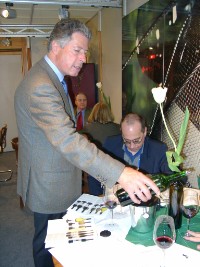 SSchreckbichl Colterenzio): This is one of the largest and most successful cellar cooperatives in South Tyrol, cultivating about 300 hectares of vines. The chairman Dr. Luis Raifer (in the picture) leads us through parts of his program. Besides good basic qualities (Classic Line and Praedium Selection), the wines of the Cornell prestige line are particularly convincing: Pinot Gris: Sauvignon and Chardonnay in the white range and Cornelius Rosso as well as the great Lagrein (98) particularly pleased us. The Lagrein would be a good suggestion for a monthly wine for the wine regulars' table!
SSchreckbichl Colterenzio): This is one of the largest and most successful cellar cooperatives in South Tyrol, cultivating about 300 hectares of vines. The chairman Dr. Luis Raifer (in the picture) leads us through parts of his program. Besides good basic qualities (Classic Line and Praedium Selection), the wines of the Cornell prestige line are particularly convincing: Pinot Gris: Sauvignon and Chardonnay in the white range and Cornelius Rosso as well as the great Lagrein (98) particularly pleased us. The Lagrein would be a good suggestion for a monthly wine for the wine regulars' table!
To the homepage
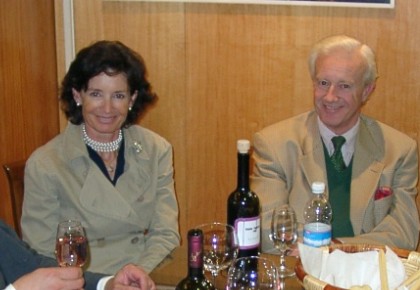 |
| Two of three owners at Conti Bossi Fedrigotti: Maria Jose Visconti di Modrone and Gian Paolo Bossi Fedrigotti |
From the Trentino we visited Conti Bossi Fedrigotti. From the basic qualities to the top of the range, the quality spectrum was very different, but overall appealing. For some time now, a new oenologist (Luca d'Attoma) has been responsible for the wines. A clear quality leap has been noticeable since then.
To the homepage
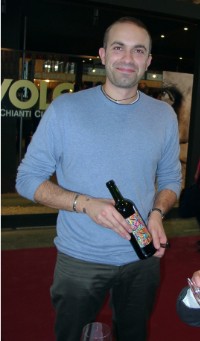 Alessi "Cennatoio" from Tuscany is also a family-owned company. After wine production was more of a hobby at first, the Alessis converted the estate entirely to viticulture in 1985. The success has rewarded this step. The wines are also known outside Italy; 90% of the production is exported. The tasting was extensive: Innominato, Il Vino, Chianti Classico Cennatoio, Chianti Classico Leandro, Etrusco, Mammolo, Arcibaldo, Rosso Fiorentino and finally the new top wine of the estate each in two different vintages (usually 98 and 99). It was worth it. Alessi is not only a committed producer but also produces corresponding qualities. He builds, by the way, contrary to the general trend, not on Cuvees but on the single-varietal development of his wines. In the picture on the left: Emiliano Alessi
Alessi "Cennatoio" from Tuscany is also a family-owned company. After wine production was more of a hobby at first, the Alessis converted the estate entirely to viticulture in 1985. The success has rewarded this step. The wines are also known outside Italy; 90% of the production is exported. The tasting was extensive: Innominato, Il Vino, Chianti Classico Cennatoio, Chianti Classico Leandro, Etrusco, Mammolo, Arcibaldo, Rosso Fiorentino and finally the new top wine of the estate each in two different vintages (usually 98 and 99). It was worth it. Alessi is not only a committed producer but also produces corresponding qualities. He builds, by the way, contrary to the general trend, not on Cuvees but on the single-varietal development of his wines. In the picture on the left: Emiliano Alessi
To the homepage
At Poliziano we were guided through the program by the owner Dott. Federico Carletti. Of the wines tasted (Chianti Classico 2001, Rosso di Motepulciano, Vino Nobile 99, Morellino di Scansano, Asinone 99 and Le Stanze del Poliziano 2000) the Morellino particularly caught my eye. Poliziano bought the Lohsa estate and is now growing Morellino there under its own name. A complex, mineral and exciting wine with a good price-performance ratio. All in all, a very convincing collection. It is not for nothing that this is one of the most famous producers in Tuscany.
To the homepage
At Castello di Brolio / Barone Ricasole we finished relatively quickly after a few wines. Somehow the wines didn't really excite me. Even the Caselferro (99), which has been shining for years with three glasses in the Gambero Rosso, couldn't change that. Of course, one has to admit self-critically that the wines after Poliziano certainly did not have an easy time, so the judgment might be a little unfair.
To the homepage
On Sunday we skipped the Vinitaly and instead followed an invitation of the star vintner Lageder to South Tyrol. Lageder does it wisely: He renounces his participation in the Vinitaly and instead transports the visitors from Verona to his two estates in Margreid by bus shuttle. There, he can choose whom he invites and entertain his guests with the saved fair costs in an excellent and perfect way and present his wines. More about this in a separate report.
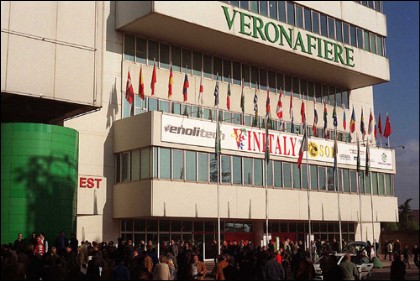
In the picture: The trade fair building with the depressing name "World Trade Center"
On Monday, back at Vinitaly, exhibitors could see the exhaustion from Sunday. Someone put it this way, that Sunday is really just to pour some wines "so you don't have to bring so much home again". At some booths, however, many wines, brochures etc. were already drunk or sold out on Monday.
Our first port of call was Giacomo Bologna "Braida". We tried two white wines (Il Fiore and Asso die Fiori) and of course some red wines: Il Baciale, Bricco dell'Uccellone 99, Bricco della Bigotta and a specialty, Grignolino d'Asti. Grignolino is an old, autochthonous grape variety in the Langhe, which has five to six seeds instead of the usual four. As a result, the wine must be drawn off the skins more quickly than usual. What remains is a rosee-like colour and very hard, slightly bitter tannins. Montebruna 2001, a new "experimental wine" used to experiment with four underground vines and two clones, as well as the Bricco della Bigotta 99 were my clear favorites.
To the homepage
Afterwards a short stop at Rocche dei Manzoni, the producer of the wine forum monthly wine Quatr Nas. After Bricco Manzoni 99 and Barolo 98 we could convince ourselves that the 99 Quatr Nas is similarly complex and appealing as the 96 first edition tasted at the wine forum regulars' table.
At Vietti, we only wanted to taste Barbera due to time constraints. Of the four 2000s, Tre Vigne, Scarrone, Scaronne Vagna Veccia and the 99 La Crena, the latter two were clearly the winners. We were then persuaded to have a '96 Barolo from the house. The 10-minute delay to our next appointment was more than rewarded by the fine tannins and beautiful hints of leather and licorice.
To the homepage
The next appointment at the Consorzio del Vino Brunelllo di Montalcino gave us the opportunity to get a very extensive cross-section of the Rosso of the year 2000 and the Brunello of the year 97. From all the wines of the producers affiliated to the Consorzio, we were able to tick our preferred candidates on a list in advance. These were then presented to us one after the other. The result was a flight with about 20 Rosso and 30 Brunello. In the overall very disappointing program, the following Rosso caught my eye positively: Col d'Orcia 2000, Mastrojanni, Palazzo and Carpazo. Among the Brunello, which were also not quite satisfactory overall, the following stood out upwards: La Magia, Casanuova delle Cerbaie, Fattoi and Astrojanni.
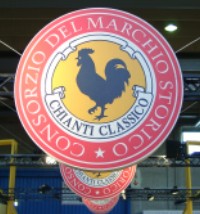 After a lunch break, Chianti Classico was the order of the day. At Consortio Chianti Classico we had the next mammoth flight set before us. Worth mentioning here: Castello Vicchiomaggio 2000, Cennatoio Riserva 98, Leandro Allessi, Leandro Allessi Riserva, Fonterutoli 99, Fattoria Le Fonti 2000, Fattoria Le Fonti 1999 Riserva, Le Bocce 2000, Le Bocce 1998 Riserva, Casanuouva di Nittardi 2000, Castello di Volpaia 98 Riserva, Borgo Scopeto 99 Riserva, Vignole Riserva 98 and Villa Calcinaia 2000
After a lunch break, Chianti Classico was the order of the day. At Consortio Chianti Classico we had the next mammoth flight set before us. Worth mentioning here: Castello Vicchiomaggio 2000, Cennatoio Riserva 98, Leandro Allessi, Leandro Allessi Riserva, Fonterutoli 99, Fattoria Le Fonti 2000, Fattoria Le Fonti 1999 Riserva, Le Bocce 2000, Le Bocce 1998 Riserva, Casanuouva di Nittardi 2000, Castello di Volpaia 98 Riserva, Borgo Scopeto 99 Riserva, Vignole Riserva 98 and Villa Calcinaia 2000
All in all, however, the disappointment prevailed here, too, unfortunately.
During the whole fair, the Italian exhibitors were by far in the majority. For the rest of the world, there was just half a hall. The title "International Wine Fair" must therefore be questioned, at least in terms of exhibitor participation. The presence of German producers was practically nil. It was almost limited to the Dual System Germany and Underberg. The Austrians were better, but overall also poorly represented and Switzerland was also there with only 12 exhibitors. We were told several times that in the meantime, ProWein has become so important for these exhibitors compared to Vinitaly that a visit to Verona is hardly worthwhile anymore
At least this was not the case for us as visitors. The two days were worth it for us. There is hardly any other place where you can get to know Italian wines in such a compressed and effective way. When we then left Verona sometime in the evening through agonizing traffic jams in the direction of Germany, there was no question for us: Ciao Verona! - until next year.